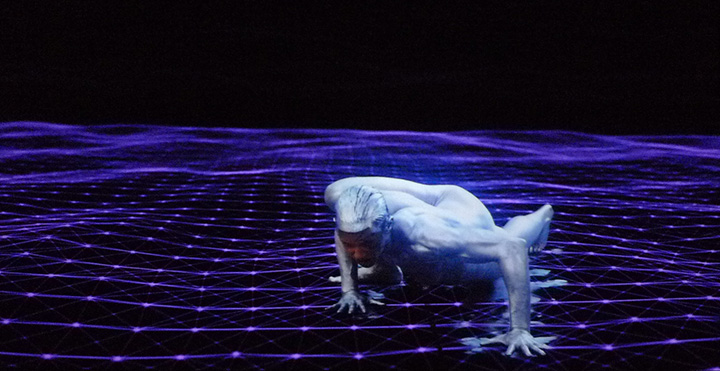Archive for the ‘art and activism’ Category
Reading: The Making of the Indebted Man (note 1)
I’ve been reading Maurizio Lazzarato’s 2011 book The Making of the Indebted Man translated to English and published by semiotext(e) in 2012. If some of the promises from the last two years – to excuse student debt, to acknowledge institutionalized racism as a national level, I feel that we have come a long way over the last 10 years and since the last financial disaster in considering how the system is rigged and how to begin to chip at it, to create a more equitable society. Perhaps this is too hopeful.
Lazzarato is clear and direct and presents a rich set of resources for anyone looking to jump into researching a history of debt and our current financial mechanisms. Many of his ideas and critiques could easily be applied to more recent altcoins and fintech tools. I’m going to copy below a few sequences that strongly stand out to me, mostly for my own notes, but perhaps others will be interested…
From the Forward
Through readings of Nietzsche’s Genealogy of Morality and Marx’s theory of money, it will help us revive two hypotheses. The first, that the paradigm of the social lies not in exchange (economic and/or symbolic) but in credit. There is no equality (of exchange) underlying social relations, but rather as asymmetry of debt/credit, which precedes historically and theoretically, that of production and wage labor. The second hypothesis, that debt represents an economic relationship inseparable from the production of the debtor subject and their “morality.” The debt economy combines “work on the self” and labor, in its classical sense, such that “ethics” and economics function conjointly. The modern notion of “economy” covers both economic production and the production of subjectivity. Traditional categories rooted in 19th and 20th century revolutions – labor, society, and politics – are now informed and in large measure have been redefined by debt. (Pg. 11)
From Chapter 1 Understanding Debt as the Basis of Social Life
Credit bring us back to a situation characteristic of feudalism, in which a portion of labor is owed in advance, as serf labor, to the feudal lord. – Jean Baudrillard, The System of Objects (pg. 13)
Debt acts as a “capture,” “predation,” and “extraction” machine on the whole of society, as an instrument for macroeconomic prescription and management, and as a mechanism for income redistribution.” (Pg. 29)
This is generally true for any financial mechanism; they are funded by and created for the rich to accumulate greater wealth. Take for example FinTech software from Robinhood to Coinbase to alt coins, the goal of many of these are not to democratize investment, but to break into the pockets of a larger population and use their money.
“We have moved from Fordist regulation, which privileged the industrial and debtor side, to financial regulation, which prioritizes the financial and creditor side.” (Pg. 30)
But debt is a universal power relation, since everyone is included within it. Even those too poor to have access to credit must pay interest to creditors through the reimbursement of public debt; even countries too poor for a Welfare State must repay their debts. (Pg. 32)
Chasing Bits a Web Platformer Game

“No Media” is an online exhibition featuring art work entirely made from code. This means no media files – no jpg or gif or png or mp3 or wav or mp4 or webm or any type of self-contained file type. When I was invited to participate in this exhibition, it was a tricky proposition for me as I’m primarily a visual artist who uses software and generally when I code it’s in an environment such as Visual Studio with Unity. My web projects tend to include SVGs created in Illustrator or video or audio files… But I greatly appreciated the invitation and the challenge to work differently. However, I’m not a good coder, generally, I hack things together or review endless tutorials. In grad school at Carnegie Mellon University, I was allowed to enroll in the Computer Science intro to programming undergraduate course. This is a course designed to weed out those who will not go on to become programmers; I lasted three weeks.
I regularly use javascript, the language of the web, I wanted to make something that would be fun for people to interact with and I had been researching digital currencies for the last couple of years for another project. Since I was 11 years old, I’ve loved platformers due to my initiation as Activision’s Pitfall Harry in 1982. So I decided to take Marijn Haverbeke‘s entirely code-based javascript platformer game covered in his book Eloquent Javascript and inject it with a bit of Bitcoin and alt coin content. I feel that the platformer presents the ideal game metaphor for the dreams and pitfalls of alt coins. The game titled Chasing Bits has audio, but it’s the browser’s speech synthesis that reads a hidden text (no media). And there are emojis that may appear to be image files, but are also bits of code. (It’s probably time to add the death emoji.). There is one live data feed – the current value of Bitcoin which you may update throughout the game.
Since web audio generally requires a user event, players must click a button to trigger the browsers reading of the following passage:
What happens when a utopian idea for a decentralized currency gains adoption in the midst of hypercapitalism? Speculative investors looking to get rich quick, loose. The early bird gets the worm, the rest just dig for fools gold. Or perhaps the current value of bitcoin will triple and you head straight to the Cayman Islands to sip on rum and coke as you lazily sway in a hammock between shade and sunlight.
Unfortunately it is 2022, the U.S. government slowed the printing of free money, inflation has risen, uncertainty has set in and the happy go lucky period of Bitcoin and alt coins has taken a pause. Sit tight, wait 10 years and just maybe those Ethereum coins will be worth eighty thousand each! Or perhaps, the Financial Action Task Force may just clamp down and regulate Bitcoin and digital currencies due to money laundering and other criminal use of digital currencies. No one knows what lays ahead. So meanwhile, why not chase those bits…
I can not afford real property, so I buy land in the metaverse. I like going there in the evenings when I sit alone and wonder when others will join. Perhaps I will rent out some space and make more bits. However, I don’t like it when the earth quakes.
As soon as Bitcoin peaks again, I will buy a pig to store clones of all my primary organs, this way I will double my life span and live to a 180 and by then I will own a country in the meta verse and deliver my own currency. My anti gravity suit will keep me looking young. Meanwhile I will continue chasing bits.
Try the Chasing Bits, listen to that audio, check the current value of Bitcoin, I hope you are mildly entertained!
Review of “The Linguistic Errantry”
Imagine an immersive Boschian landscape rich with metaphoric allusions of surveillance and control, such is artist Tansy Xiao’s latest creation. The desktop application “The Linguistic Errantry” puts the user/player in a surreal yellow hued environment populated by singing giraffes, floating goldfish, levitating eggs, flying surveillance cameras and a giant broken egg with octopus tentacles dancing about. In a desert-like setting, enclosed by rock cliffs, Marxist monuments stand erect but their heads are 19th century copper and brass diving helmets. A buddha on lotus monument is surrounded by surveillance monitors that show the world itself as captured by the roving surveillance cameras. This world reflects upon “the totalitarian lockdown in Shanghai.”
“The Linguistic Errantry” is a first person roaming world. Walk past any of the 14 giraffes and you will hear it singing brief notes.
Each giraffe is set to sing a measure constituting 2-4 notes and nonlinguistic lyrics deconstructed from L’Internationale. When two giraffes collide, they adopt each other’s measure to add to their own array. Giraffe 0 as the only exception, is set to speak “Control / Your / Soul’s / Desire / For / Freedom” by default, instead of singing—a propaganda phrase from a government official during the totalitarian lockdown in Shanghai, when the whole country entered an Agambenian “state of exception.” Each word occupies one slot in its array and will be gradually replaced by fragments from L’Internationale as giraffe 0 encounters the others of its kind.
https://www.tansyxiao.com/the-linguistic-errantry
As game engines have become more accessible and adopted by artists to create immersive worlds layered with meaning and cultural critique, it is exciting to see Xiao adopt the game platform to create a powerful metaphoric world that easily stirs investigation and reflection in the viewer. As Xiao further describes “The Linguistic Errantry reimagines the Tower of Babel in a way that manifests the arbitrary nature of history: the consolidation and disintegration of sovereigns, an anticipated revolution to be generated by mere chance, or a parallel universe where nothing ever happens and only entropy reigns supreme.”
The Golden Age of FinTech
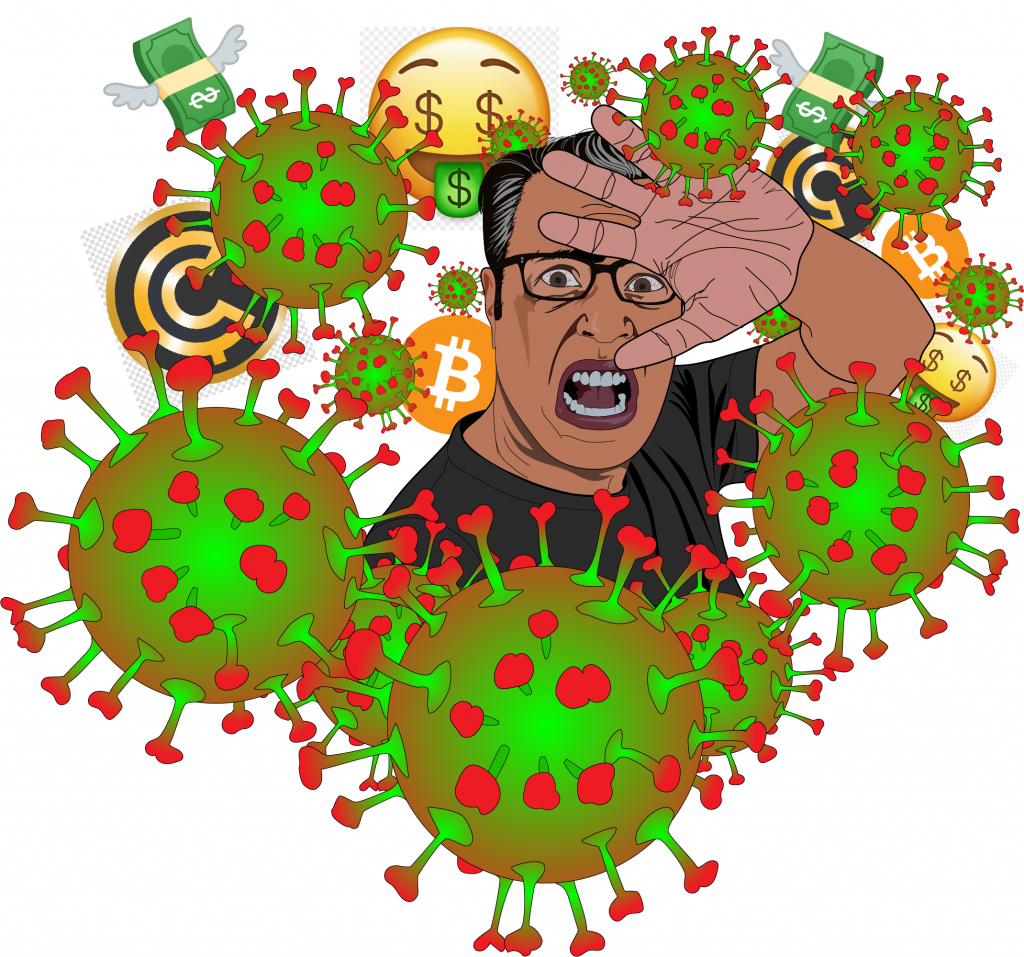
FinTech for the Precariat (working title) is a net art work that speculates on the false promises of income distribution in the Age of Bezos. COVID-19 has compounded existential insecurity; the pandemic of stress has been inseminated by the novel flu virus to birth a new reality – a chasm of uncertainty. As unemployment soars, speculative futures drive a stock market that has largely rebounded from the initial shock, but on what basis? The basis that this moment will soon pass and the age of plutocrats, technocrats and authoritarianism will continue thriving a year from now; the slight disruption soon forgotten. The agenda of economic growth must be embraced at the cost of human health. After all, those who enjoy the economic growth will remain safely at home in their condo or rural cabin or yacht.
It has been projected that the 2020s will be the decade of the FinTech Revolution. This marketing hyperbole is on the heels of many such revolutions – the Green Revolution, the Personal Computing Revolution, the dot.com, web2.0 and Social Network Revolution… These revolutions are sold on the promises of democratization and wealth. And they always leave a toll from cancer and the privatization of agriculture to unparalleled surveillance. Today financial technologies present the promise of democratizing complicated transactions, facilitating personal banking, mass speculation in stocks… Whether budgeting or gambling, these tools are relatively harmless. However, entirely new finance mechanisms or rather schemes are being developed as part of FinTech including autonomous finance, bitcoin and ultimately the financialization of human existence. A sector of FinTech will compound income inequality nationally and globally to insurmountable levels. As made abundantly clear by world leaders, finance no longer serves humanity, humanity serves finance.
Nicaraguan LGBTQ Community
I recently read the essay “Tacit Subjects” by Carlos Ulises Decena in which the author interviews several homosexual individuals from the Dominican Republic. Decena focuses on the coming out or not of gay Dominican men to their families. Amongst the subjects interviewed for the essay, their homosexuality is unspoken but recognized by their family members, hence the title “Tacit Subjects.”
Upon reading the essay, I was immediately transported to the awe that I felt in 1995 upon witnessing my first Torovenado in Masaya, Nicaragua. Throughout my life I had only visited Nicaragua during the summer and I had enjoyed the initial celebrations of the three month festivities for San Jeronimo, the patron saint of my mom’s hometown – Masaya. El Torovenado – a satirical procession occurs at the end of the celebrations – the final Sunday of October. In 1995, I moved to Nicaragua for an extended period and the uncle with whom I was living, invited to take me to El Torovenado. Mi Tio Jorge enjoys a good party and is not particularly religious, so I was a little surprised that he’d want to go to the culmination of a saint’s festivities. However, I noted a mischievous spark in his eye and I agreed to join him on the 20 minute drive to Masaya.
I was dumbfounded upon seeing a giant gay parade in my mom’s hometown. It was as if the San Francisco Castro that I grew up with had transported itself to Masaya. There, before me, was the Lion’s Club (El Club de Leones) Queen – queen of the parade – a proper queen, entirely in beautiful drag. Everywhere I looked the rainbow flag was flying high. I think my uncle truly enjoyed at how speechless I was.
The culmination of this Catholic festivity had been co-opted by the gay community and everyone appeared to be fine with it. Since El Torovenado is a satirical procession in which people are allowed to mock anything and everyone – from historical figures to the most powerful political figures, in retrospect, it makes sense that the gay community took over this particular day of celebration; after all it’s a day of freedom, when social norms are discarded. El Torovenado is alternately called La Parada de los Cochones.
I feel that Nicaragua has always been more accepting of its gay community than other Latin American countries and I think that the 1979 victory of the Sandinistas allowed greater freedom for the LGBTQ communities through the 80s. The Torovenado allows the large numbers of the gay community to gather and party. Here is a 5 minute video documentation of the 2017 Torovenado (before the current Ortegista repression and militarization of the country):
In relation to the gay Dominicans featured in “Tacit Subjects,” these are people (primarily men) who are out and proud and the public persona that they present particularly in a festive procession may be very different than who they are with their family. Perhaps the acceptance of the gay community in Nicaragua allows young people to come out and discuss sexuality more openly than in the DR and it is not such a tacit subject. However, macho culture exists as in the rest of Latin America and I would not be surprised if a large portion of this community is alienated from their birth families and have constructed or adopted new families based on their sexuality.
There is an interesting book that I’ve only read passages from that goes in depth regarding the gay community following the Sandinista revolution – Intimate Activism: The Struggle for Sexual Rights in Postrevolutionary Nicaragua by Cymene Howe. The book discusses El Torovenado:
according to Erick Blandon, the Torovenado is a ‘moment of escape from oppressive heterosexual masculinity and a dialogic engagement between different sexual subjects where homoeroticism becomes the center of attention for both homosexuals and heterosexuals.’ While transvestics are not the quotidian norm in Nicaragua, it is clear that the country has had a public and symbolic space for these kinds of gendered performances.
Howe, Cymene, Intimate Activism: The Struggle for Sexual Rights in Postrevolutionary Nicaragua, Duke University Press, 2013
With the current violence and repression by the Ortega dictatorship, I wonder how the LGBTQ community is doing. Have they become a tacit community? Are they remaining in-doors as does the majority of the population come nightfall? The LGBTQ Nicaraguan population has largely thrived due to the safety and acceptance of the country, but with assassins trolling the streets, freedom and expressiveness may no longer be available. It is so sad that the military leaders will allow a single couple – Ortega and Murillo hold an entire country hostage and have destroyed the legacy of a popular revolution.
Dictator Cycle
The series of work titled Dictator Cycle has a specific moment of inception – January 29th, 2014 when I heard that the Nicaraguan National Assembly had elected to do away with presidential term limits, effectively allowing, the current president Daniel Ortega to remain president throughout the remainder of his life.
With each manipulation of the Nicaraguan constitution by Ortega and the Sandinista party, I feel a deep sadness for the impoverished country, the birthplace of my parents and where I spent the best days of my childhood. I am also dumbfounded at the short-sightedness of the ruling party and the ignorant avarice of Daniel Ortega who will not hand over the political reigns of the country to a new generation.
Prosperity has been illusive to this small country that has suffered a long-lasting dictatorship, natural disasters, a popular revolution and seemingly inherent political corruption. If only true leaders would emerge who seeks an end to corruption and the engineering of a society striving for the well-being of all its people. Unfortunately, since the Nicaraguan National Assembly elected to eliminate presidential term limits, an end to poverty and corruption appears as distant as the worst period of the Somoza dynasty. Ortega has effectively become Somoza.
Nearly a year later, I illustrated Stalin/Putin out of anger of the increasingly draconian laws in Russia such as the “bloggers law” and “anti-gay law”. Following Stalin/Putin, I started work on the “Dictator Cycle” as an illustrative series depicting once young and noble leaders who had become corrupt autocrats unwilling to surrender power. Each “Dictator Cycle” pairing is alive today or their reign continues to have very real consequences upon the country. For example, although Gaddafi has been killed, Libya continues in disarray. Although Kim Il-sung died in 1994, his grandson Kim Jong-un is North Korea’s current supreme leader and is shown to perhaps be the most ruthless of the family dictatorship.
Pope.L Bougie Irreverence
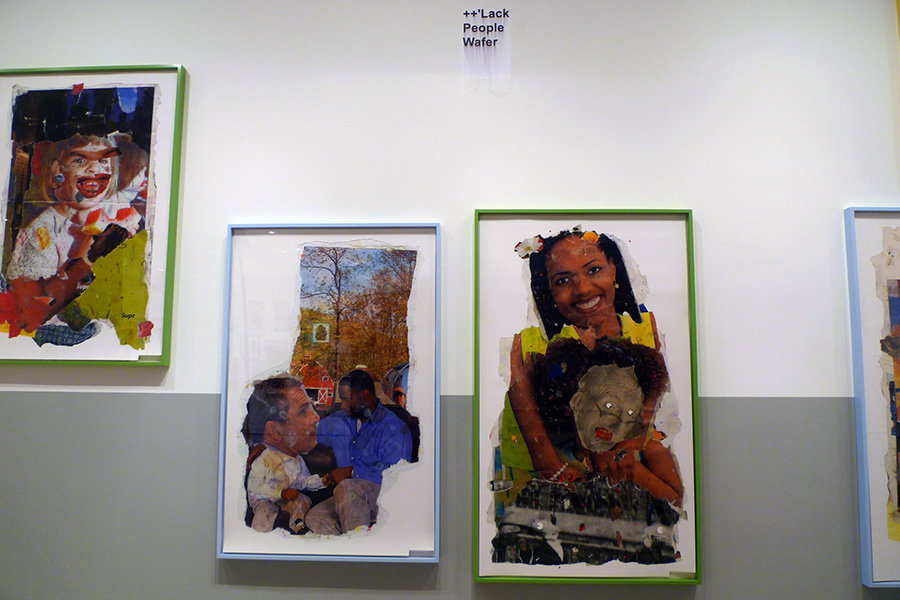
It is difficult to call any art placed in a blue chip Chelsea gallery irreverent, but Pope.L tries his best. Currently (9/13 – 10/27 2018) at Mitchell-Innes & Nash, Pope.L “One Thing After Another (Part Two)” stocks the gallery with collaged digital prints, framed found trash, assemblage, photo-collage, and a video of an erect penis attempting to balance a white whip cream pie. (As you might guess, the cream pie tips off the big, hard, black dick; only Brett Kavanaugh’s small white penis would hold that pie up.) The video is hilarious and I wish I had recorded a bit of it to include it here. It is a sharp and whimsical comment on desire, sex, race and privilege or rather lack of. The white pie and black dick are accompanied by a smoking digital black sock puppet that rises and forms like a snake from a corner of the video image.
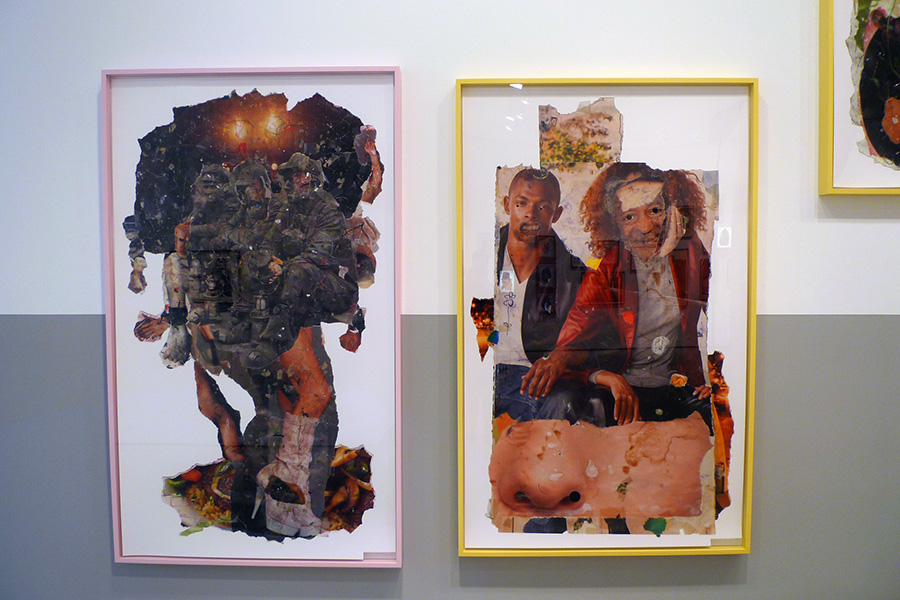
The digitally printed collages tear apart political and celebrity figures, mockingly reframing them in unexpected contexts and pairings. Across the gallery, William Pope.L has inserted himself into historical photographs. Again, the visuals are at once comical and critical recontexualizing a problematic racial history of the United States.
Pope.L effectively reminds us to always look at the images we are fed with a critical eye. Question the images – where are they coming from, why are they being presented and what is it that they represent? What is our place in this culture? But in the end, lets not take ourselves too seriously, be creative, have fun, but always be smart.
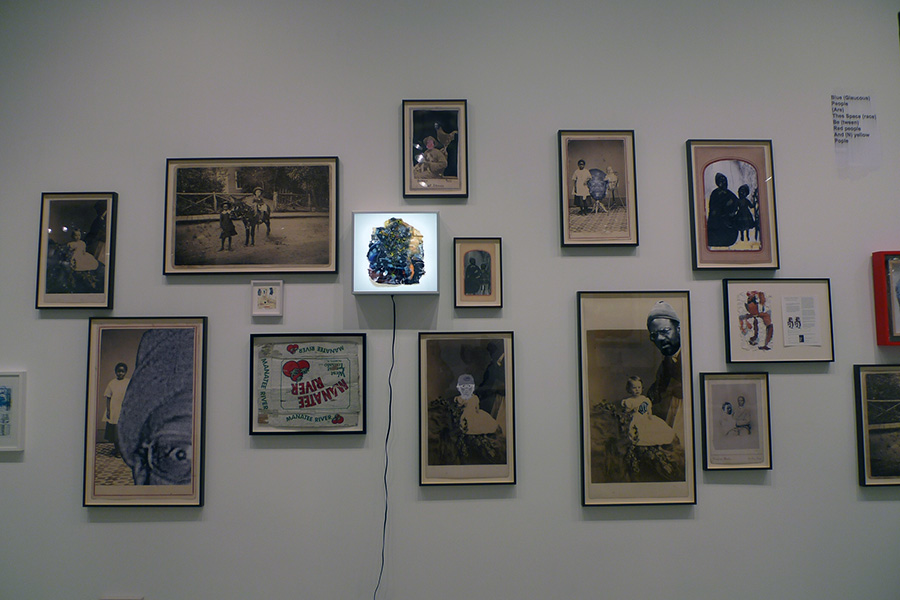
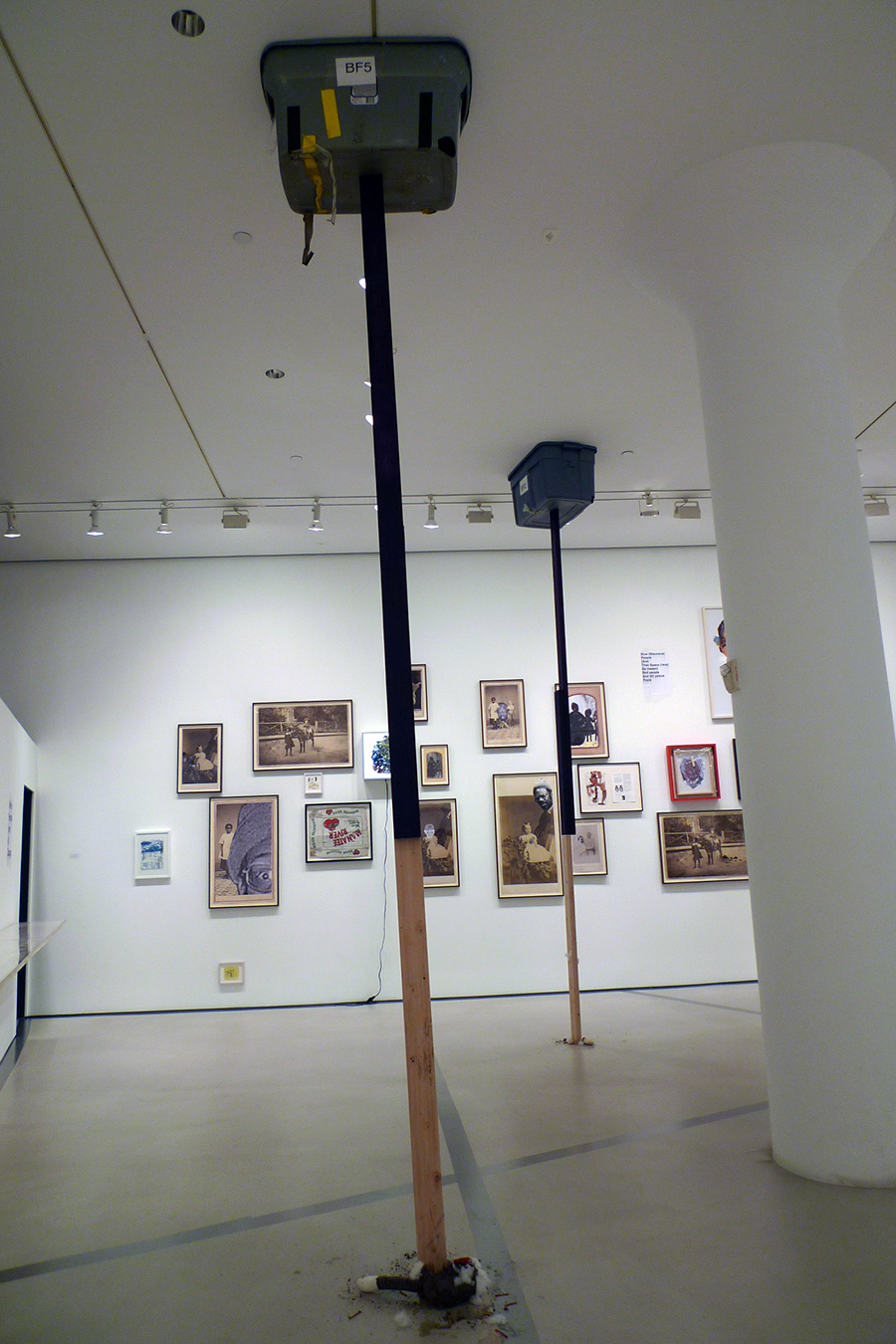
NEGOCIO at Centro Cultural Las Cigarreras de Alicante
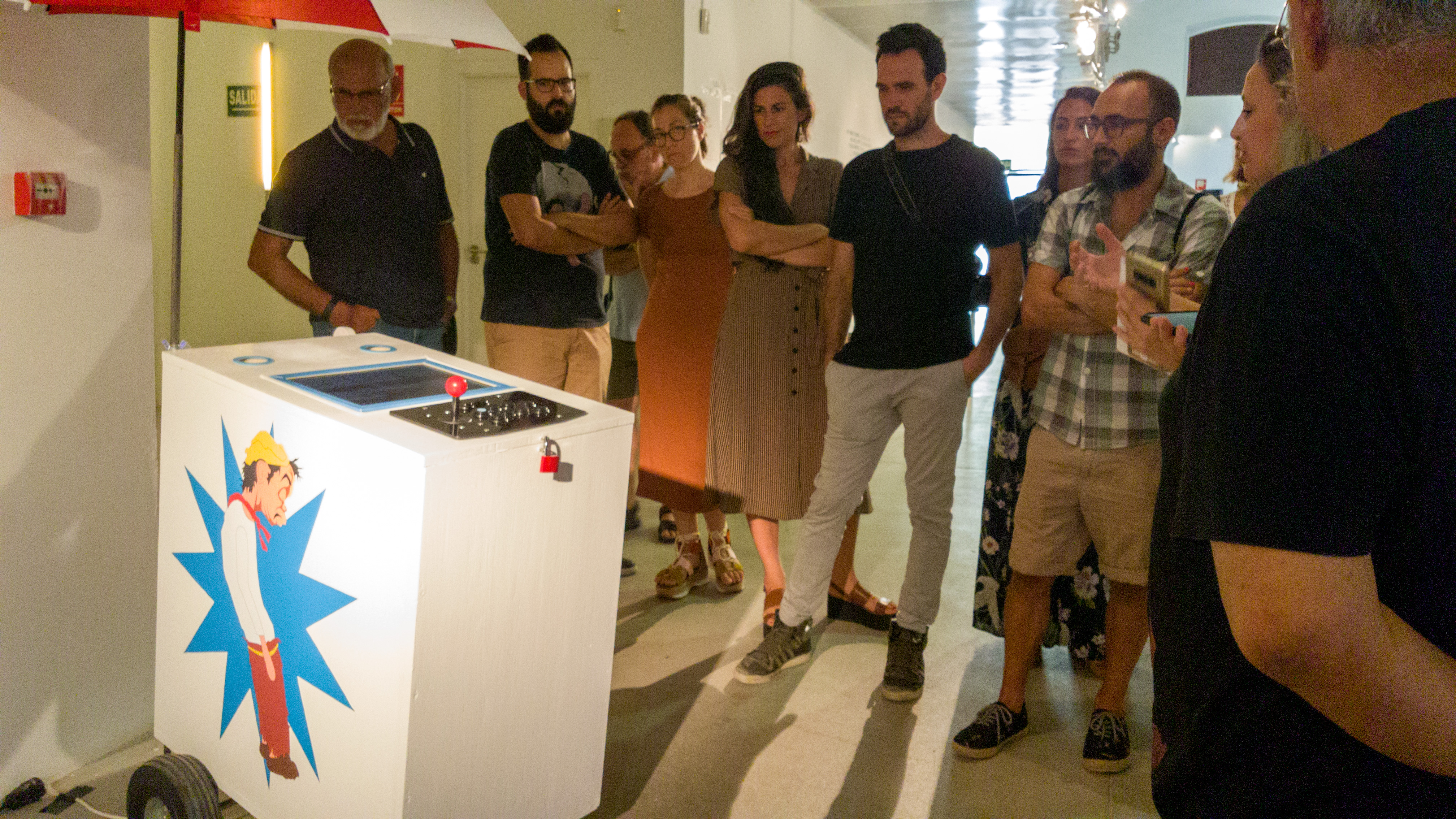
NEGOCIO at el Centro Cultural Las Cigarreras de Alicante is an ambitious attempt to present an archive of the creation of games as art largely over the last twenty years, though one work – “White Chess” by Yoko Ono dates back to 1966. The majority of works have been created in the 21st century. The exhibition presents a mix of digital and analog games and the vast majority of the exhibition is interactive – allowing visitors to play the games on exhibit as intended by the artists.
I’ve been honored with the inclusion of VAGAMUNDO: A Migrant’s Tale (2002) included the exhibition (pictured above). This is a sculpture and video game originally presented on the street that unfortunately is as timely today as 16 years ago due to the Trump administration’s stance regarding immigration.
The curators – David Machado Gutierrez, Alba Garcia Martinez, Beatriz Martinez-Villagrasa and Miguel Soria Andurell state:
The origin of the game, is lost in the memory of time; the game is perhaps as old as the very existence of the human being on earth. But what does the game transmit to us today apart from its playful appearance? Can art use it as a tool that reflects on challenges and social reality? Does it also work as an act of criticism? This exhibition does not pretend not to answer these questions, since it would be too ambitious, but it is formulated so that the spectator participates and, using the works of art as a guide. The exhibition investigates in the multiple planes what may unfolds in games as art.
Below are a selection of photographs documenting the exhibition.
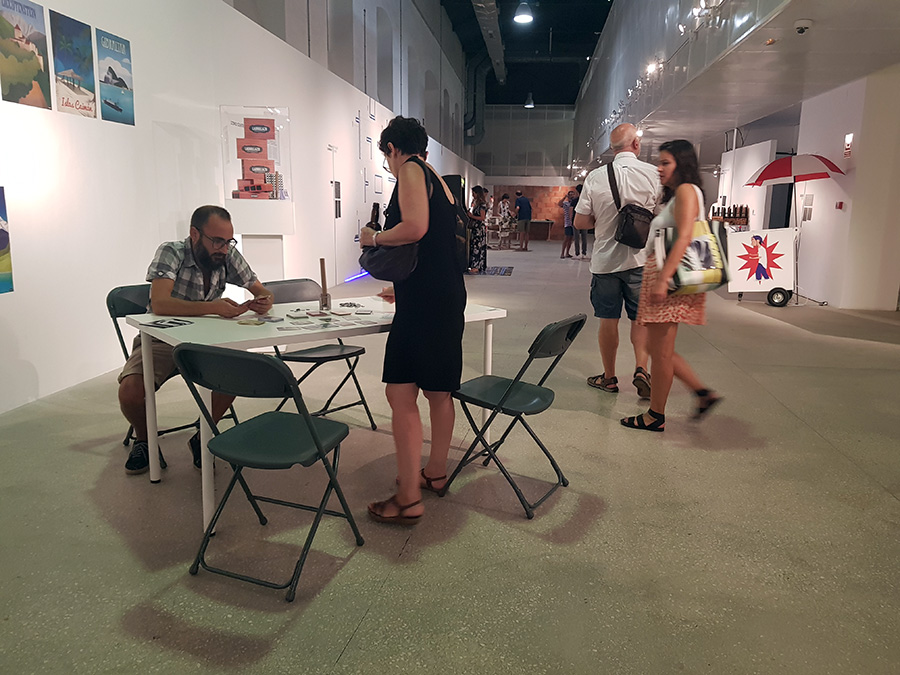
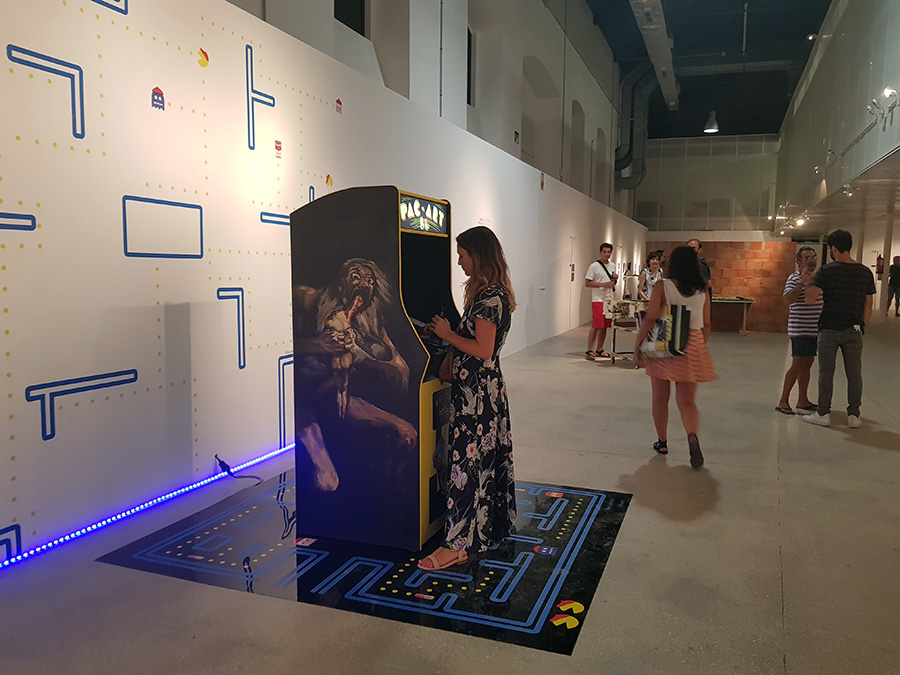
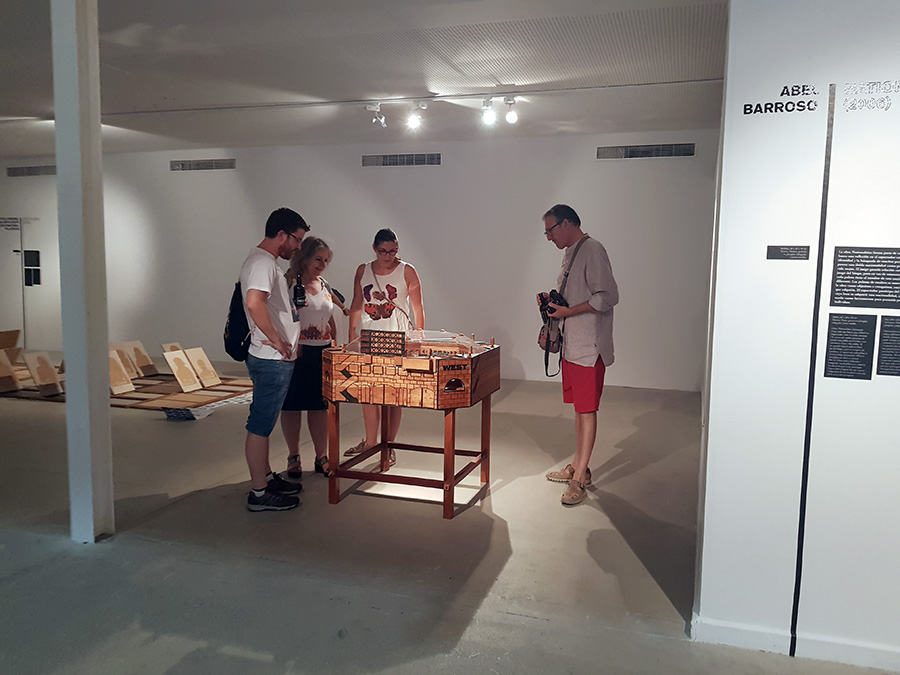
Two game sculptures by Cuban artist Abel Barroso

Carlos No’s Intifada – a “ping-pong table which, in place of a net, has been divided into two halves by a very high brick wall, topped by barbed wire that heightens a feeling of insurmountabilty. There arises in the spectator the curiosity of seeing the other side, the place which one is forbidden to see and be in, as if one had discovered Lewis Carrol’s charade in the passage to the other side of the looking-glass. In this wonderland that comprises this side and the other side, both the space and the visitor’s steps are divided into two.”
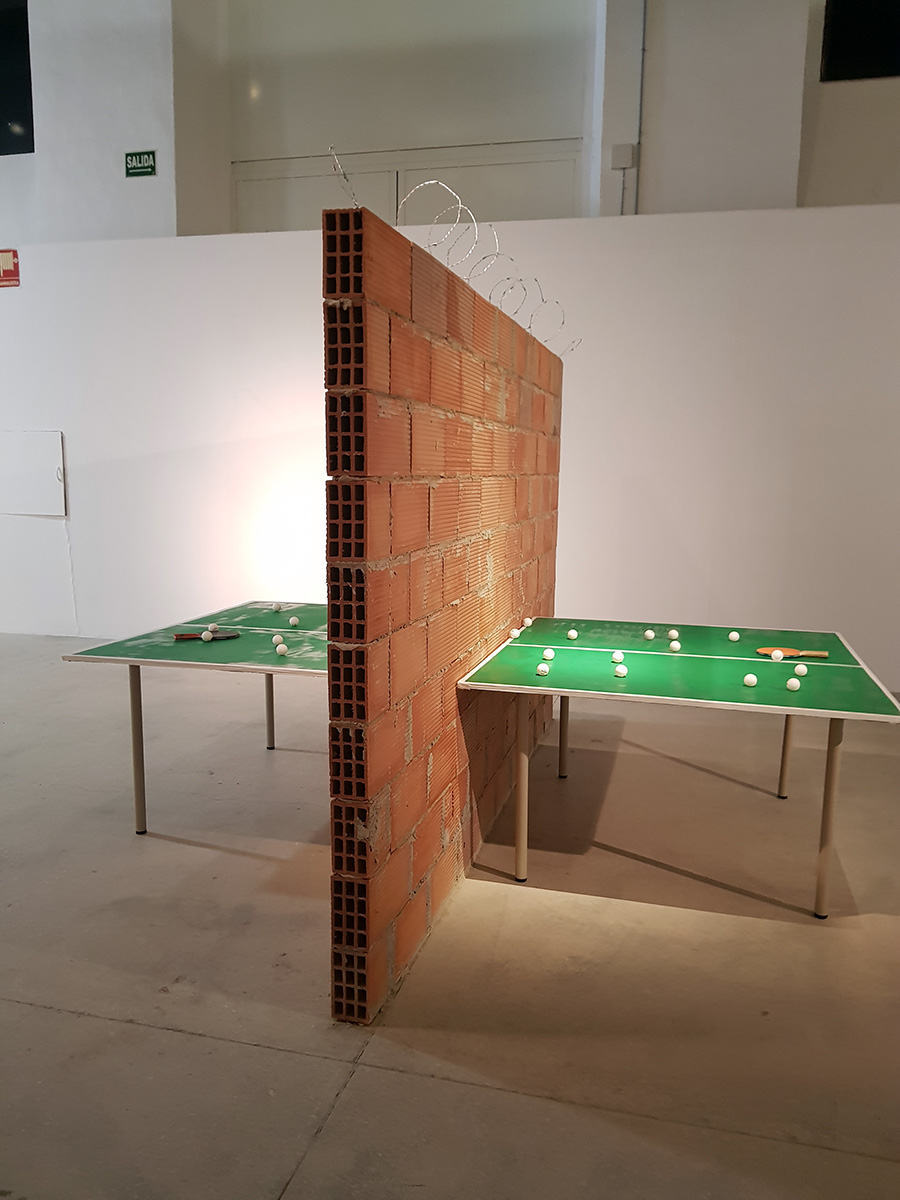
“Velvet-Strike is a mod of the first-person shooter video game Counter-Strike. The mod, developed by Anne-Marie Schleiner, Joan Leandre, and Brody Condon, adds “protest sprays” to the game’s existing graffiti function.”
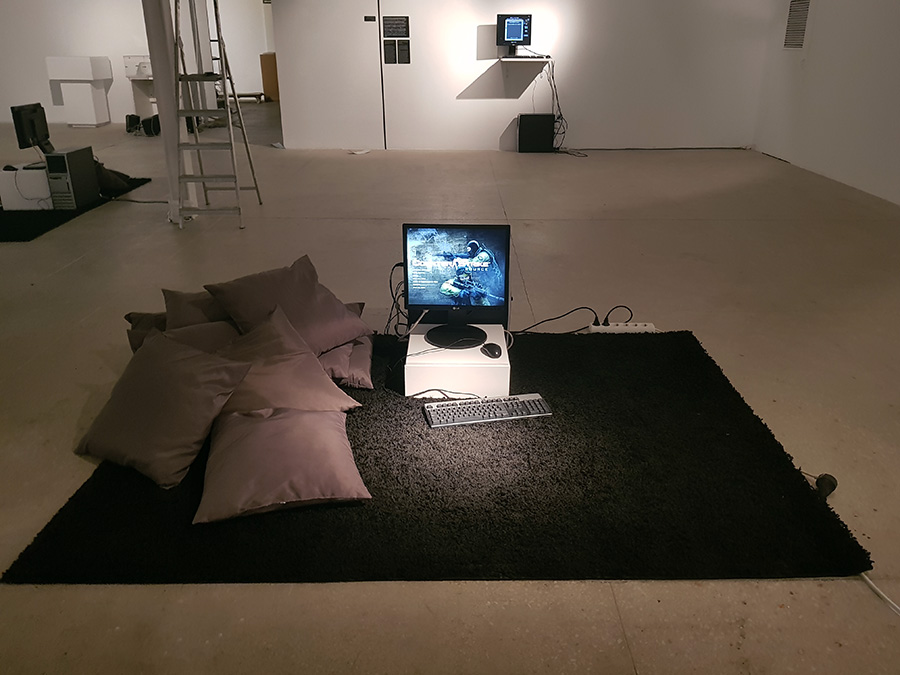
“Ladrillazo is a historical game that takes you to the real estate bubble of the first decade of the 21st century. There were days of wine and roses, an interpretation center in each town, an airport in each city, mortgages at 40 years, masons with minister salaries, Olympic dreams, AVEs and golf resorts.”
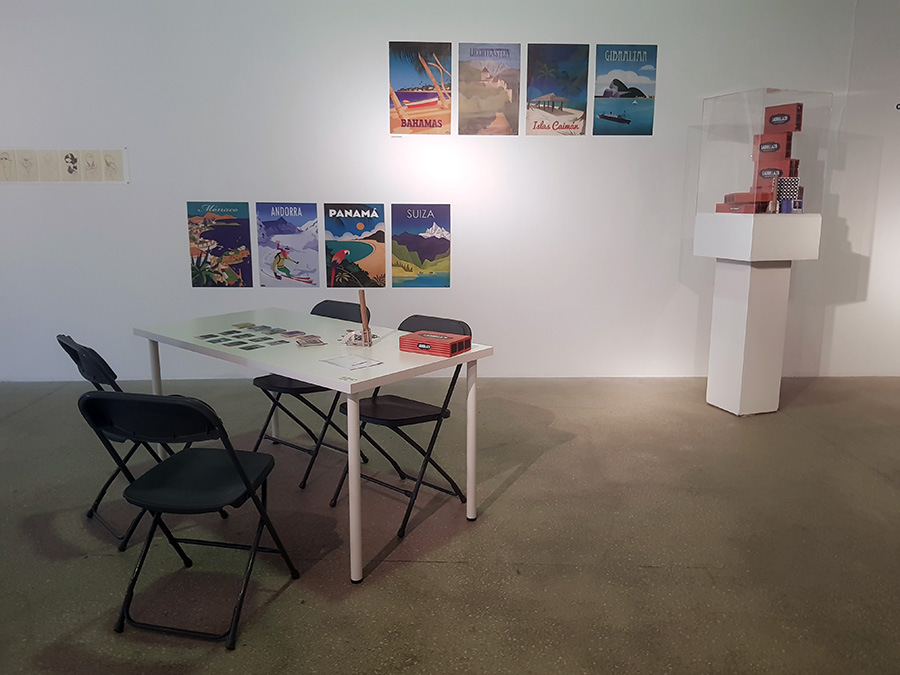
“Pac-Art is a version of the immensely popular Arcade video game Pac-Man. In this case, Pac-Art has transformed Pac-Man into an artist who has to devour famous works of art and flee from ghost-artists who threaten him.”
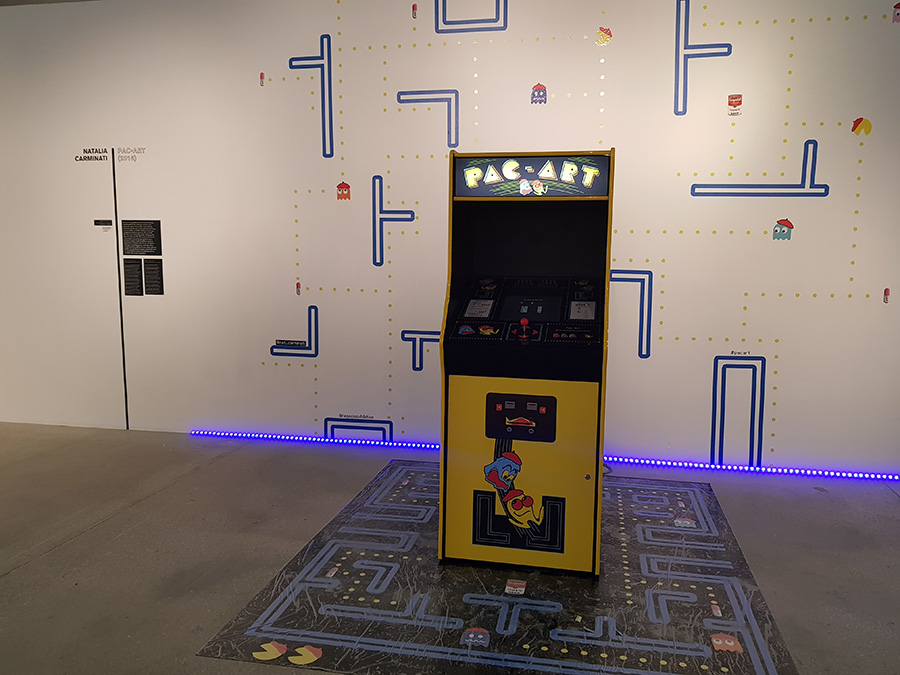
Ravalpoly by Alba Refulgente – a game of real estate speculation in Barcelona that re-contextualizes the game Monopoly.
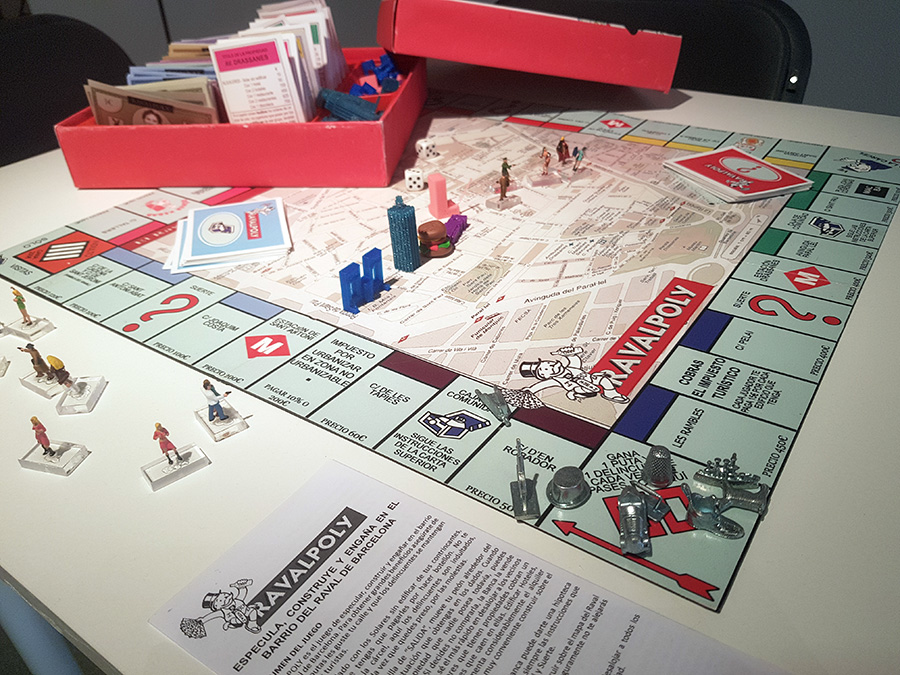
Visitors will have the opportunity to play Yoko Ono’s “White Chess.”

Many other artists and game makers are included in this exhibition, including Brenda Romero, Connor Monahan, Molleindustria, Richard Hofmeier, Jason Rohrer, Joan Priego amongst others. And one more image of VAGAMUNDO:

Trump Chases Out Kids
Following travel, Iggy had a week off from summer camps, so we got to enjoy the week together. I proposed that we make an animation. He was game. I gave him a drawing pad, showed him Richard Williams’s The Animator’s Survival Kit and he started drawing. After a few minutes, I look over at the drawing pad and say “That looks like Trump! Are you drawing Trump?” Iggy: “Yes, a naked Trump. Lets make an animation of naked Trump chasing immigrants…”
Over the following few days, Iggy drew each of the characters: Trump, a female immigrant, a male immigrant and lastly decided to add ICE police. Iggy was firm on having the ICE police shuffle along. He drew each of the steps of the run cycles for each of the characters and I did the coloring. With the art work done, I took over setting up the timeline with tweens and finding various backgrounds to reflect the United States. Iggy made the call on the background sequencing.
I had two audio clips of Trump flip flopping on treatment of undocumented kids to give the animation a soundtrack. Lastly, I found a sound clip of Homer taking a fall which seemed like a fitting culmination.
Zach Blas Contra-Internet at Art in General
Contra-Internet: Jubilee 2033 trailer from Zach Blas on Vimeo.
I had been looking forward to seeing Zach Blas’s Contra-Internet exhibition at Art in General, unfortunately it was not as engaging as I had hoped. The exhibition presents one single channel video installation that features the nearly 30 minute film “Jubilee 2033” and three other single-channel video works on monitors. The three video works on monitors present ideas and research regarding the internet – the hegemonic network of today and for the foreseeable future – through computer screen recordings by Blas. (I really hope that artists stop using screen-recordings of themselves clicking through files as a medium; it’s seldom interesting.)
Although I was disappointed by the exhibition, the gravity dance performance by Cassils as Nootropix, “a contra-sexual, contra internet prophet” is captivating an entirely worth the trip. The premise of the film is funny as it opens with Ayn Rand discussing the future of her ideas with two of her followers – Alan Greenspan and a fictional character Joan Mitchell. A young Greenspan proposes that the group take an acid trip. I was turned off by the highly accented performance of Rand and her cult, so I was glad to see them drop liquid acid.
As the trip begins, an internet connected artificial intelligence in the form of a manga character appears and takes them in to the future. The future is of course dystopian as the present reality burns and it’s certainly fun seeing the Google headquarters burning along with other tech companies in the not so distant future of 2033.

Along their travels, we encounter tech workers being taken hostage by “The Art Professor” wearing gray, paint-splattered coveralls and wielding a machine gun. Later in a classroom, the Art Professor introduces Nootropix (Cassils) who in their monologue states that they will perform the creation of gravity. The performance artist is powerful and their dance upon a purple matrix while dawning a large, erect, glowing CGI penis that is constantly spewing black liquid is awesome. The dance is mesmerizing and triumphant.

In Nootropix, Blas presents one of his contra-internet exotic creatures “to discover or create a world of network difference.” I could have entirely skipped the storyline, and merely be fantastically transported by Cassils’s character and performance as I think that it would have left me asking more questions and appreciating the mystery. We know that a network of difference is not plausible, so why not create the fantastic and shed the tedious philosophizing.
